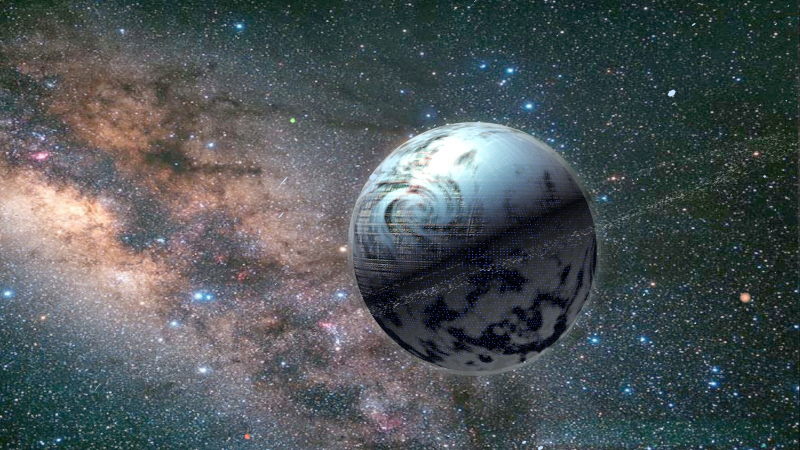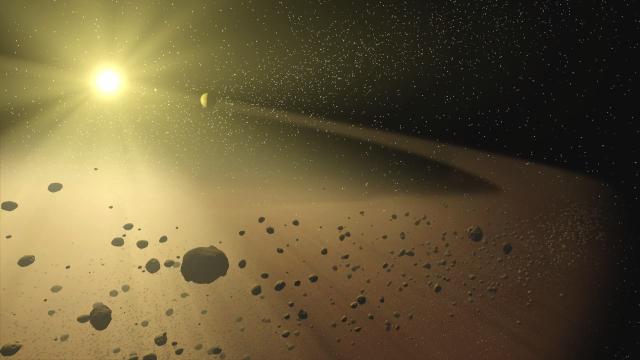The results are now in after a year-long, crowdfunded investigation into the star KIC 8462852, and to hardly anyone’s surprise, the strange dimming produced by this star doesn’t appear to be caused by an alien megastructure. That said, astronomers are now significantly closer to knowing the true reasons for the star’s odd behaviour.
Variable star KIC 8462852, also known as Tabby’s Star and Boyajian’s Star, is located more than 1,000 light years from Earth. It’s about 50 per cent larger than our Sun, and nearly 1,000 degrees hotter. But thanks to observations made by the Kepler Space Telescope from 2009 to 2013, we know that this otherwise normal star experiences sporadic and intermittent dimming (at least from our vantage point on Earth). These mysterious drops in luminosity are by as much as 22 per cent, sometimes lasting for days. A recent historical analysis of Tabby’s Star showed that changes to the object’s overall brightness are on timescales lasting for years to centuries.
Astronomers hadn’t seen anything quite like it before, leading to a stream of theories. Explanations included a swarm of comets, a recently-annihilated planet, a distorted star, gravity darkening, and even alien megastructures.
In May 2016, Louisiana State University astronomer Tabby Boyajian set up a Kickstarter in hopes of securing funding for future research, and space fans donated more than $US100,000 ($127,840). These funds were used to support a dedicated, ground-based telescopic survey of Tabby’s Star at the Las Cumbres Observatory in Goleta, California, which worked in tandem along with a network of professional and amateur telescopes around the world. In all, nearly 2,000 people were involved in the survey, the results of which have now been published in The Astrophysical Journal Letters.
The star’s behaviour was closely monitored from March 2016 to December 2017. Beginning in May 2017, astronomers managed to chronicle four distinct dimming episodes, dubbed Elsie, Celeste, Scara Brae, and Angkor by Kickstarter supporters who got to nominate and vote for the names. The dimming persisted for several days to weeks. After the four dips (collectively known as Elsie, which is derived from the “LC” of Las Cumbres Observatory, the most generous Kickstarter backer), the star exhibited strange and unexpected brightening for a couple of months.
The recurrence of these dimming episodes was a big deal, not least of which because it finally ruled out instrumental effects from Kepler (which was thought unlikely anyway). It was also the first time that scientists were able to observe the dimming in real-time.
Looking at the photometric and spectroscopic data, the researchers were able to rule out an alien megastructure (such as a sun-enveloping Dyson sphere), while affirming a theory proposing that the star is surrounded by ordinary space dust.

Artist’s impression of a Dyson sphere. To get a sense of scale, the outer shell would be located approximately 1 AU from the enveloped star, or roughly 150 million km, depending on the configuration. (Credit: Slawek Wojtowicz)
Tyler Ellis, an astronomy grad student at Louisiana State University and a co-author of the new study, says the data collected by Las Cumbres Observatory and other observatories effectively rules out an alien megastructure, but he admits it’s a tricky issue because we don’t know exactly how an alien civilisation might build a megastructure, or the kinds of materials they would use.
“If we can assume that the construction would be done with normal building materials, then we would expect that it would be opaque and absorb light monochromatically,” Ellis told Gizmodo. “This would result in an overall dimming of the star without selectively absorbing particular colours. This is exactly the opposite of what we are reporting. The Las Cumbres observations show that the occulting material, whatever is blocking the star light, preferentially absorbs blue light. This has the effect of reddening the stellar spectrum.”
What’s more, and as Ellis points out, a Dyson sphere-like object would absorb the star’s light, causing the structure to heat up and subsequently emit infrared radiation that should be detectable from Earth.
“This light radiated by the structure would create an infrared excess,” said Ellis. “Such an excess is observed in young stars with large amounts of coalescing gas and dust. We did not observe any infrared excess. We need to search at longer wavelengths in order to better constrain this though.”
It’s also important to point out that, if the dimming was truly caused by an alien megastructure, the intermittent nature of the flickering would likely be on account of a partial Dyson sphere, or one under construction. If the latter, the odds of our observing such a fleeting event are mind-bogglingly implausible (it shouldn’t take an advanced alien civilisation very long to build such a thing).
Penn State astronomer and study co-author Jason Wright, who first speculated about a potential alien megastructure, says it’s unlikely that large, solid objects are blocking our view of the star’s light.
“If there were opaque objects blocking our view of the light, the star should get equally dim at all wavelengths,” he wrote at his blog. “Instead, [we find] that the blue dips are much deeper — about twice as deep — as they are when we look at infrared wavelengths… the dips are not caused by opaque macroscopic objects (like megastructures or planets or stars) but by clouds of very small particles of dust (less than 1 micron in typical size). We can also say that these clouds are mostly transparent (‘optically thin’ in astrophysics parlance).”
Further analysis ruled out accompanying gas (which favoured the cometary theory), or a companion object in orbit around the star.
But this mystery is far from over. Wright likes the “space dust” hypothesis, but there are several explanations — ranging from the plausible through to the seriously unlikely (such as an orbiting black hole disk), that still need to be ruled out. Our galaxy’s most mysterious star is still ripe for further research.
There’s still plenty of data that needs to be analysed by various groups, explained Ellis, and his team is continuing to refine its observations and analysis. Funds from the Kickstarter campaign have been used to purchase more telescope time for the upcoming observing semester with Las Cumbres. And ideally, Ellis is hoping to use an infrared instrument on a space-based telescope to scan Tabby’s Star during a dimming event to get a better sense of the size of the dust particles and their location around the star.
As the team prepares for this next phase, Ellis is keen to point out that this work was made possible only because of the “trust and generosity” of the Kickstarter backers and the contributions of amateur astronomers and citizen scientists.
“The target was discovered by ordinary people with free time and the follow up work funded by ordinary people with a few spare bucks,” Ellis told Gizmodo. “This target could have very well been left undiscovered in the Kepler data archive. This project would not have stood a chance before any standard funding agency or telescope allocation committee; scientists simply cannot ask for a few minutes every night on a telescope or for funding for essentially a fishing expedition. I hope that we have shown that worthwhile science can be done on crowdfunding platforms.”
